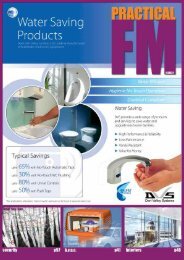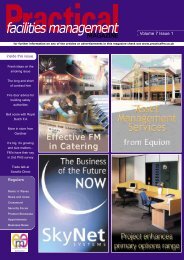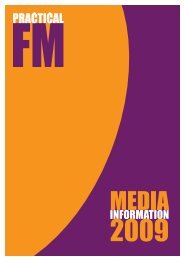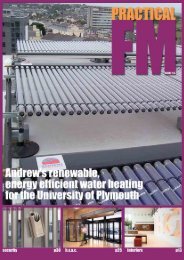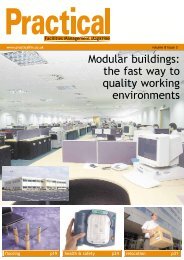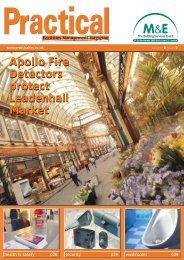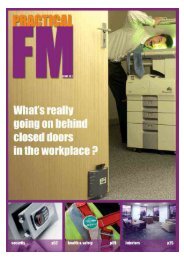Where are your priorities? - Practical Facilities Management
Where are your priorities? - Practical Facilities Management
Where are your priorities? - Practical Facilities Management
Create successful ePaper yourself
Turn your PDF publications into a flip-book with our unique Google optimized e-Paper software.
security focus<br />
Case Study:<br />
University of East Anglia<br />
University of East Anglia (UEA), located just<br />
outside Norwich city centre, has more than<br />
13,000 students studying on campus, and over<br />
2,000 employees.<br />
The city had donated what was the Earlham<br />
municipal golf course for the site of the campus,<br />
and traces of the fairways can still be seen<br />
around the grounds today. In 1962, Denys Lasdun<br />
was appointed as UEA’s founding architect. It<br />
was Lasdun who designed the University’s core<br />
buildings -the monumental Teaching Wall, the<br />
raised walkways, the central Squ<strong>are</strong> and the<br />
now famous ziggurats. The striking ziggurats <strong>are</strong><br />
like none other - the student accommodation,<br />
lining the embankment, <strong>are</strong> pyramidal in shape.<br />
While the historical buildings remain, new buildings<br />
and residences have also been developed.<br />
These developments and the increasing expectation<br />
of student accommodation acted as key<br />
drivers for a review of access on the campus.<br />
Jonathan Richardson, Access Control Project<br />
Manager & Senior Systems Specialist for<br />
Corporate Information Systems has championed<br />
the roll out of Cardax FT for the University.<br />
From his previous position as editor for an IT<br />
publication, he relished in critiquing a system to<br />
see if it was all it was supposed to be.<br />
We needed a system that would give us the ability<br />
to keep using what we currently have, and<br />
create an infrastructure to be able to develop it<br />
over time to how we envisage the system one<br />
day operating, he says.<br />
The import and export facilities have made the<br />
system ideal for combining data from a range of<br />
student, personnel and accommodation systems.<br />
We already had 42,000 cards in circulation<br />
there was no way we could replace them.<br />
Cardax was chosen for its ability to work with<br />
third party card formats.<br />
Card data is imported/updated using the import<br />
export service with data from the Envision card<br />
production system. We additionally use data<br />
from a student system, accommodation system<br />
and a couple of bespoke databases to automatically<br />
calculate access groups. Changes to access<br />
Seven disparate systems, tens of thousands of existing cards in circulation,<br />
new buildings requiring new systems, budget constraints. There <strong>are</strong> two<br />
approaches going forward: keep making it work, or work on a plan to<br />
centralise the system for some serious long-term efficiencies.<br />
groups <strong>are</strong> again handled via the import export<br />
service. There is no way we could realistically<br />
manage the level of changes with a manual system.<br />
We rely totally on the automatic<br />
Jonathan Richardson, Access Control Project<br />
Manager & Senior Systems Specialist, University<br />
of East Anglia imports to add and remove access<br />
as required.<br />
The integration is massive, and the impact it is<br />
having in terms of pulling different information<br />
sources together is huge.. Jonathan describes<br />
the system as being a catalyst for change on<br />
how security, data storage and management<br />
across a range of systems and databases <strong>are</strong><br />
viewed.<br />
The implementation has been very transp<strong>are</strong>nt,<br />
people <strong>are</strong> unaw<strong>are</strong> of the changeovers that<br />
have taken place. The dynamic updates <strong>are</strong> now<br />
happening, and the system is probably at least<br />
four times more secure now. Jonathan mentions<br />
the difference made by the level of technical<br />
support available from the manufacturer, from<br />
the UK and even head office (based in New<br />
Zealand) dialling in when required.<br />
Cardax FT controls a full range of devices<br />
including doors, automatic swing and slide<br />
doors, car park barriers, turnstiles and elevators.<br />
The system also facilitates electronic<br />
access for disabled flats for residents in<br />
wheelchairs. System Division functionality is<br />
used to give building owners their own portion<br />
of the system for management purposes.<br />
For car parking, times <strong>are</strong> recorded for charging<br />
parking fees. Louis Chisholm, Transport Co-ordinator,<br />
uses the Cardax FT system on a daily<br />
basis. When asked how she finds the system<br />
Louis replies, I love it. I can check all the things<br />
I need to without asking anyone else. She uses<br />
the reporting to check for people tailgating, and<br />
checking any enquiries for specific cards.<br />
From parking to the library: students enter the<br />
library through turnstiles. Reports on usage patterns<br />
have been used to justify access funding to<br />
promote the resource. The audit trail has been<br />
called on for incidents occurring in the library<br />
that have put staff safety at risk, and even disputes<br />
on the return of books.<br />
Research laboratories and chemical stores rely<br />
on the system; previously dangerous chemicals<br />
have gone missing with no knowledge of who<br />
was there at the time.<br />
The University has around 150 doors (30 Cardax<br />
FT Controllers) using third party magstripe readers.<br />
There <strong>are</strong> additionally around 20 Cardax<br />
Prox (125 Series) readers used in secure <strong>are</strong>as<br />
via a dual technology card. We have plans to<br />
change the existing 125 Prox to Mif<strong>are</strong> and then<br />
roll out dual function cards to all cardholders<br />
replacing magstripe readers with Cardax Prox<br />
Mif<strong>are</strong> readers, explains Jonathan. Once converted<br />
this would take into consideration different<br />
facets - from the cafeterias to involving the<br />
local bus companies - in the use of the smart<br />
card technology.<br />
The success of Cardax in centralising access control<br />
and reporting has meant the system is being<br />
expanded rapidly, and introducing new functionality<br />
is ongoing. Jonathan is planning for highlevel<br />
integration with CCTV, and room booking<br />
and timetabling systems.<br />
UEA have opted for a Cardax FT Softw<strong>are</strong><br />
Maintenance Agreement (SMA) to ensure their<br />
system remains current. The situation of the<br />
seven disparate systems we inherited was a<br />
direct result of allowing systems to become outdated,.<br />
says Jonathan.<br />
Reader Reply<br />
No.: 84018<br />
46<br />
www.practicalfm.co.uk



